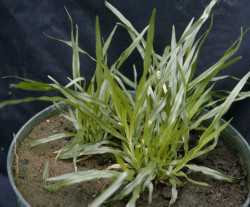Found In Florida: Notorious Noxious Weed Makes Way To U.S.

Chrysopogon aciculatus, a perennial grass known as golden false beardgrass, lovegrass, or Mackie’s pest was recently detected in Miami-Dade County. This plant, a federally listed noxious weed, has not previously been reported to be established in the Continental U.S., although it is found in Hawaii. It is a serious agricultural and environmental weed, particularly in the Old World tropics, and is included on the Noxious Weed Lists of USDA and several states, including Florida. This grass was found near the Homestead Air Reserve Base and was subsequently mowed and treated with herbicide. Initial surveys of the nearby environs have located no additional outbreaks.
This perennial grass grows by stolons that spread quickly over the soil or become buried shallowly in the soil. Leafy, sterile, short shoots may grow from the stolons as well as fertile stems 15 to 25 centimeters (cm) tall with leaf sheaths that can have pale stripes of green and white or darker and lighter green or with hints of purple. The leaf blades are 2 to 8 cm long, 3 to 5 millimeters (mm) wide, with rough edges.
The inflorescence is a panicle, 3 to 6 cm long, with a red-purple color. The branches of the panicle are whorled and held stiffly upward. The spikelet clusters are 6 to 8 mm long, and break from the pedicel (flower stalk) along a diagonal ridge covered with golden brown hairs that becomes a needle-like, bearded barb about 3 to 7 mm long. The seed or grain is about 2 mm long. The barb remains attached to the seed to aid in its spread in fur or on clothing.
This grass might be similar to a number of other grasses, depending on the life stage and frequency of mowing where it is found. In flower, this species could appear to be a miniature Johnson grass, but if the area has been recently mowed, the grass might resemble St. Augustine grass.
The grass is usually found in sunny, dry, exposed areas such as roadsides, lawns and pastures. It is native to tropical India and China, and perhaps parts of the Pacific region, but has been widely introduced in other tropical areas of Asia, Australia, and the Pacific. This grass has been used as a groundcover or turfgrass, in spite of the potential hazard when it is allowed to produce seeds.
Chrysopogon aciculatus has the potential to spread quickly as the creeping stolons grow over open areas. The grass can tolerate grazing, mowing, and trampling by animals. This grass can be difficult to eradicate, and therefore costly, if it becomes established.
This grass is difficult to identify unless flowers are present. When in flower, the grass can be recognized by the combination of short, leafy shoots and a taller sheath with an inflorescence of whorled branches with purple flowers. Control of weedy perennial grasses usually requires the application of herbicides.









